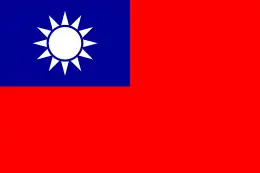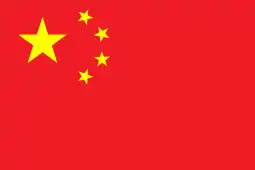This is a list of the heads of state of the Republic of China (ROC) since 1912 and the state representatives of the People's Republic of China (PRC) since 1949.
List of presidents of the Republic (since 1912)
This is a list of the presidents of the Republic of China (ROC) (1912–present). The Republic of China president is called 總統 (Zǒngtǒng, "President"), and from 1912–1928, 大總統 (Dàzǒngtǒng, "Grand President").
Since 1949, the de facto territory of the ROC is reduced to Taiwan and its surrounding islands, the former previously ruled by Japan from 1895 to 1945, no longer governing mainland China. It continued to represent China in the United Nations until it was expelled on 25 October 1971 and diplomatically by the United States government until 1 January 1979. The President of the ROC is also known as the President of Taiwan due to the territory it governs.
All the names on this list follow the Oriental convention with the family name first and given name second.
Provisional Government: Tongmenghui
Beiyang clique, etc.
Beiyang Government: Beiyang clique, etc.
Progressive Party/Research Clique
Communications Clique
Nationalist to Constitutional Government: Kuomintang
Democratic Progressive Party
Presidents of the Provisional Government | ||||||||
| No. | Portrait | Name (Birth–Death) |
Term of office | Political party | Vice President | Assembly (elected) | ||
|---|---|---|---|---|---|---|---|---|
| 1 | .jpg.webp) |
Sun Yat-sen 孫中山 (1866–1925) |
1 January 1912 | 10 March 1912 | Tongmenghui | Li Yuanhong (Nonpartisan) |
Provisional (1911) | |
| 2 |  |
Yuan Shikai 袁世凱 (1859–1916) |
10 March 1912 | 10 October 1913 | Beiyang clique | Li Yuanhong (Nonpartisan) |
Provisional (1912) | |
Presidents of the Beiyang Government | ||||||||
| No. | Portrait | Name (Birth–Death) |
Term of office | Political party | Vice President | Assembly (elected) | ||
| 1 |  |
Yuan Shikai 袁世凱 (1859–1916) |
10 October 1913 | 6 June 1916[note 1][note 2] | Beiyang clique | Li Yuanhong (Progressive) |
1st (1913) | |
| 2 | 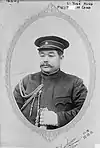 |
Li Yuanhong 黎元洪 (1864–1928) |
7 June 1916 | 17 July 1917[note 3][note 4] | Progressive Party | Feng Guozhang (Zhili clique) | ||
| — | 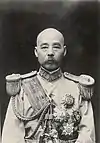 |
Feng Guozhang 馮國璋 (1859–1919) (acting)[note 5] |
17 July 1917 | 10 October 1918 | Zhili clique | Vacant | ||
| 3 | 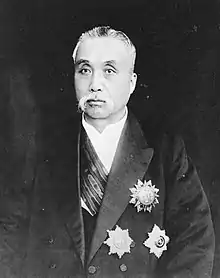 |
Xu Shichang 徐世昌 (1855–1939) |
10 October 1918 | 2 June 1922[note 4] | Anhui clique | Vacant | 2nd (1918) | |
| — | 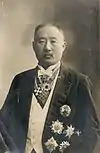 |
Zhou Ziqi 周自齊 (1871–1923) (acting)[note 6] |
2 June 1922 | 11 June 1922 | Communications Clique | Vacant | ||
| (2) |  |
Li Yuanhong 黎元洪 (1864–1928) |
11 June 1922 | 13 June 1923[note 4] | Research Clique | Vacant | ||
| — |  |
Gao Lingwei 高凌霨 (1868–1939) (acting)[note 7] |
14 June 1923 | 10 October 1923 | Zhili clique | Vacant | ||
| 4 |  |
Cao Kun 曹錕 (1862–1938) |
10 October 1923 | 2 November 1924[note 4] | Zhili clique | Vacant | (1923) | |
| — | .JPG.webp) |
Huang Fu 黃郛 (1883–1936) (acting)[note 6] |
2 November 1924 | 24 November 1924 | Nonpartisan | Vacant | ||
| 5 | 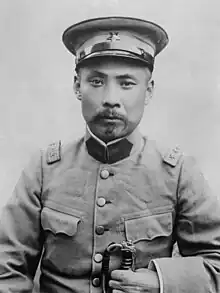 |
Duan Qirui[note 8] 段祺瑞 (1865–1936) |
24 November 1924 | 20 April 1926[note 4] | Anhui clique | Vacant | ||
| Vacant | ||||||||
| — | 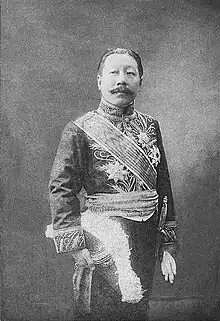 |
Hu Weide[note 9] 胡惟德 (1863–1933) (acting)[note 6] |
20 April 1926 | 13 May 1926 | Zhili clique | Vacant | ||
| — |  |
Yan Huiqing (W.W. Yan) 顏惠慶 (1877–1950) (acting)[note 7] |
13 May 1926 | 22 June 1926 | Nonpartisan | Vacant | ||
| — | 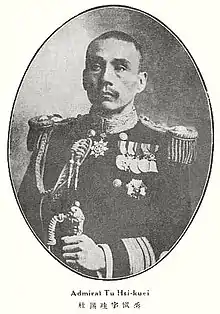 |
Du Xigui 杜錫珪 (1875–1933) (acting)[note 6] |
22 June 1926 | 1 October 1926 | Zhili clique | Vacant | ||
| — | 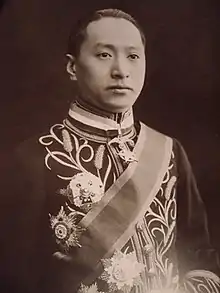 |
V.K. Wellington Koo 顧維鈞 (1888–1985) (acting)[note 7] |
1 October 1926 | 17 June 1927[note 10] | Nonpartisan | Vacant | ||
| 6 |  |
Zhang Zuolin[note 11] 張作霖 (1875–1928) |
18 June 1927 | 4 June 1928[note 12] | Fengtian clique | Vacant | ||
Chairmen of the Nationalist Government | ||||||||
| No. | Portrait | Name[note 13] (Birth–Death) |
Term of office | Political party | Assembly (elected) | |||
| — | 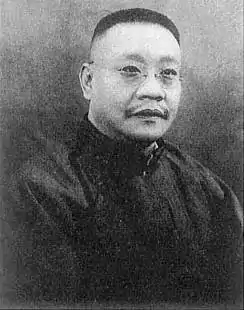 |
Tan Yankai 譚延闓 (1880–1930) |
7 February 1928 | 10 October 1928 | Kuomintang | 2nd National Congress of Kuomintang (4th plenum) | ||
| — | 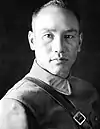 |
Chiang Kai-shek 蔣中正 (1887–1975) |
10 October 1928 | 15 December 1931[note 10] | Kuomintang | 2nd National Congress of Kuomintang (5th plenum) | ||
| — | 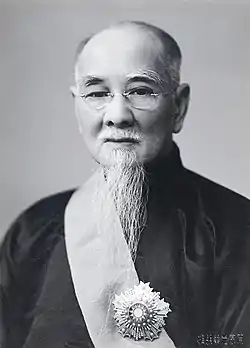 |
Lin Sen 林森 (1868–1943) |
15 December 1931[note 14] | 1 August 1943[note 2] | Kuomintang | |||
| — | 4th National Congress of Kuomintang (1st plenum) | |||||||
| — |  |
Chiang Kai-shek 蔣中正 (1887–1975) |
1 August 1943[note 15] | 20 May 1948 | Kuomintang | |||
| — | 5th National Congress of Kuomintang (11th plenum) | |||||||
Presidents after the 1947 Constitution | ||||||||
| No. | Portrait | Name (Birth–Death) |
Term of office | Political party | Vice President | Term (elected) | ||
| 1 | 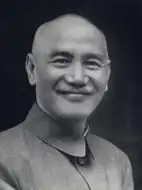 |
Chiang Kai-shek 蔣中正 (1887–1975) |
20 May 1948 | 21 January 1949[note 16] | Kuomintang | Li Zongren (Kuomintang) |
1 (1948) | |
| — | .jpg.webp) |
Li Zongren 李宗仁 (1890–1969) (acting)[note 5] |
21 January 1949 | 1 March 1950 | Kuomintang | Vacant | ||
| (1) |  |
Chiang Kai-shek 蔣中正 (1887–1975) |
1 March 1950 | 5 April 1975[note 2] | Kuomintang | Li Zongren[note 17] (Kuomintang) | ||
| Vacant | ||||||||
| Chen Cheng[note 18] (Kuomintang) |
2 (1954) | |||||||
| 3 (1960) | ||||||||
| Vacant | ||||||||
| Yen Chia-kan (Kuomintang) |
4 (1966) | |||||||
| 5 (1972) | ||||||||
| 2 | 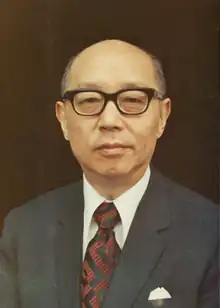 |
Yen Chia-kan (C. K. Yen) 嚴家淦 (1905–1993) |
5 April 1975 | 20 May 1978 | Kuomintang | Vacant | ||
| 3 | 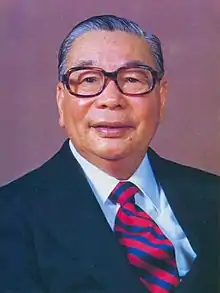 |
Chiang Ching-kuo 蔣經國 (1910–1988) |
20 May 1978 | 13 January 1988[note 2] | Kuomintang | Hsieh Tung-min (Kuomintang) |
6 (1978) | |
| Lee Teng-hui (Kuomintang) |
7 (1984) | |||||||
| 4 | .jpg.webp) |
Lee Teng-hui 李登輝 (1923–2020) |
13 January 1988 | 20 May 2000 | Kuomintang | Vacant | ||
| Lee Yuan-tsu (Kuomintang) |
8 (1990) | |||||||
| Lien Chan (KMT) |
9 (1996) | |||||||
| 5 | .jpg.webp) |
Chen Shui-bian 陳水扁 (born 1950) |
20 May 2000 | 20 May 2008 | Democratic Progressive | Annette Lu (DPP) |
10 (2000) | |
| 11 (2004) | ||||||||
| 6 | 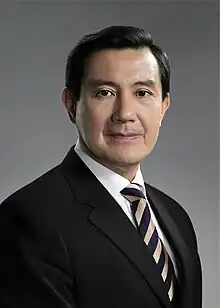 |
Ma Ying-jeou 馬英九 (born 1950) |
20 May 2008 | 20 May 2016 | Kuomintang | Vincent Siew (KMT) |
12 (2008) | |
| Wu Den-yih (KMT) |
13 (2012) | |||||||
| 7 | .png.webp) |
Tsai Ing-wen 蔡英文 (born 1956) |
20 May 2016 | Incumbent (term expires 20 May 2024) |
Democratic Progressive | Chen Chien-jen (Independent) |
14 (2016) | |
| William Lai (DPP) |
15 (2020) | |||||||
List of presidents of the People's Republic (since 1949)
This is a list of all the chairmen of the People's Republic of China (1954–1975) and the presidents of the People's Republic of China (1982–present). The President of the PRC is called 主席 (zhǔxí), formerly translated as Chairman.
To avoid confusion, all the names on this list follow the Oriental convention (family name first, given name second) for consistency.
First Administration Second Administration Third Administration Hu–Wen Administration Xi–Li Administration Xi Jinping Administration
Central People's Government under the Common Program (1949–1954)
- Chairman of the Central People's Government
- Mao Zedong (1 October 1949 – 27 September 1954)
The 1st Constitution (1954–1975)
- Chairman/Chairwoman of the People's Republic China
| Portrait | Name (Birth–Death) Constituency |
Term of office | NPC | Vice Chairman | Paramount leader | |||
|---|---|---|---|---|---|---|---|---|
| 1 |  |
Mao Zedong 毛泽东 (1893–1976) Beijing At-large |
27 September 1954 | 27 April 1959 | I | Zhu De | Himself | |
| The first Chairman of the People's Republic of China. Also served as Chairman of the Chinese Communist Party and Chairman of the Central Military Commission. | ||||||||
| 2 | 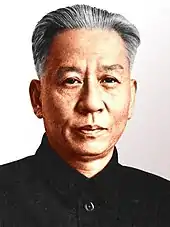 |
Liu Shaoqi 刘少奇 (1898–1969) Beijing At-large |
27 April 1959 | 21 December 1964 | II | Soong Ching-ling & Dong Biwu (co-serving) |
Mao Zedong | |
| 21 December 1964 | 31 October 1968 | III | ||||||
| Ousted by Mao Zedong during the Cultural Revolution. | ||||||||
| – | 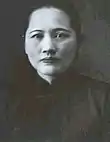 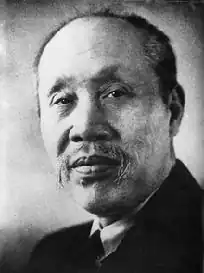 |
Soong Ching-ling 宋庆龄 (1893–1981) Shanghai At-large |
Dong Biwu 董必武 (1886–1975) Hubei At-large |
31 October 1968 | 24 February 1972 (Soong)
17 January 1975 (Dong) |
III | Vacancy by ascension | Mao Zedong |
| Both Soong Ching-ling and Dong Biwu co-served as Acting Chairpersons of the People's Republic of China until the resignation of Soong Ching-ling on 24 February 1972. Dong Biwu served the remainder of the term. | ||||||||
The 2nd Constitution (1975–1978)
- Chairman/Chairwoman of the Standing Committee of the 4th National People's Congress
- Zhu De (17 January 1975 – 6 July 1976) died in office
- Soong Ching-ling (6 July 1976 – 5 March 1978) acting
- Ye Jianying (5 March 1978 – 5 March 1978)
The 3rd Constitution (1978–1982)
- Chairman of the Standing Committee of the 5th National People's Congress
- Ye Jianying (5 March 1978 – 18 June 1983)
- Honorary President of the People's Republic China
| Portrait | Name (Birth–Death) Constituency |
Term of office | NPC | Vice President | Paramount leader | ||
|---|---|---|---|---|---|---|---|
| – |  |
Soong Ching-ling 宋庆龄 (1893–1981) Shanghai At-large |
16 May 1981 | – | V | – | Deng Xiaoping |
| The first and only Honorary President of the People's Republic of China. | |||||||
The 4th Constitution (1982–present)
- President of the People's Republic China
| Portrait | Name (Birth–Death) Constituency |
Term of office | NPC | Vice President | Paramount leader | ||
|---|---|---|---|---|---|---|---|
| 3 |  |
Li Xiannian 李先念 (1909–1992) Hubei At-large |
18 June 1983 | 8 April 1988 | VI | Ulanhu | Deng Xiaoping |
| The first President under the 4th Constitution of the People's Republic of China. He started reforms in foreign policy and China began opening to the world. He was first Chinese president who visited USA. He was also the first state president who officially visited North Korea. In 1984, Li met with US President Ronald Reagan during Reagan's visit to China, notably discussing the status of Taiwan with the President. In 1988, Li resigned from his position as President of the People's Republic of China and was replaced by Yang Shangkun. Li was then named Chairman of the National Committee of the CPPCC.[1] | |||||||
| 4 | 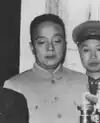 |
Yang Shangkun 杨尚昆 (1907–1998) Sichuan At-large |
8 April 1988 | 27 March 1993 | VII | Wang Zhen | Deng Xiaoping Jiang Zemin |
| The second President under the 4th Constitution of the People's Republic of China. Yang promoted economic reform but opposed political liberalization, a position which Deng Xiaoping eventually came to identify with. Yang reached the height of his political career after the Tiananmen Square protests of 1989, but his organized opposition to Jiang Zemin's leadership led Deng to force Yang to retire. | |||||||
| 5 | 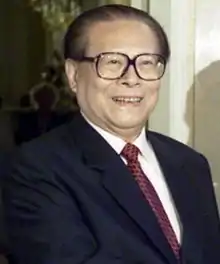 |
Jiang Zemin 江泽民 (1926–2022) Shanghai At-large |
27 March 1993 | 15 March 1998 | VIII | Rong Yiren | Himself |
| 15 March 1998 | 15 March 2003 | IX | Hu Jintao | ||||
| Under his leadership, China experienced substantial developmental growth with reforms, saw the peaceful return of Hong Kong from the United Kingdom and Macau from Portugal, and improved its relations with the outside world while the Communist Party maintained its tight control over the government. Jiang has been criticized for being too concerned about his personal image at home, and too conciliatory towards Russia and the United States abroad.[2] Served as General Secretary of the Chinese Communist Party (1989–2002), Chairman of the Central Military Commission (1989–2004), Communist Party secretary of Shanghai (1987–1989). | |||||||
| 6 | 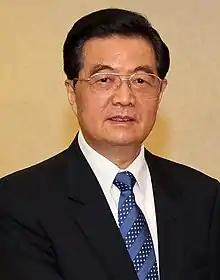 |
Hu Jintao 胡锦涛 (1942– ) Tibet At-large (until 2008) Zhejiang At-large (from 2008) |
15 March 2003 | 15 March 2008 | X | Zeng Qinghong | Himself |
| 15 March 2008 | 14 March 2013 | XI | Xi Jinping | ||||
| During his term in office, Hu reintroduced state control in some sectors of the economy that were relaxed by the previous administration, and has been conservative with political reforms.[3] Along with his colleague, Premier Wen Jiabao, Hu presided over nearly a decade of consistent economic growth and development that cemented China as a major world power. He sought to improve socio-economic equality domestically through the Scientific Development Concept, which aimed to build a "Socialist Harmonious Society" that was prosperous and free of social conflict.[4] In foreign policy, Hu advocated for "China's peaceful development", pursuing soft power in international relations and a business-oriented approach to diplomacy. Through Hu's tenure, China's influence in Africa, Latin America, and other developing countries has increased.[5] Served as General Secretary of the Chinese Communist Party (2002–2012), Chairman of the Central Military Commission (2004–2012), Vice President (1998–2003) and Vice Chairman of the Central Military Commission (1999–2004). | |||||||
| 7 | _(cropped).jpg.webp) |
Xi Jinping 习近平 (1953– ) Shanghai At-large (until 2018) Inner Mongolia At-large (2018–2023) Jiangsu At-large (from 2023) |
14 March 2013 | 17 March 2018 | XII | Li Yuanchao | Himself |
| 17 March 2018 | 10 March 2023 | XIII | Wang Qishan | ||||
| 10 March 2023 | Incumbent | XIV | Han Zheng | ||||
| The fifth President under the 4th Constitution of the People's Republic of China. Also serving as General Secretary of the Chinese Communist Party and Chairman of the Central Military Commission. Served as Vice President (2008–2013) and Vice Chairman of the Central Military Commission (2010–2012). Under his leadership, Xi strengthened mass surveillance and launched Xinjiang internment camps. Xi presided over anti-corruption campaign. In foreign policy, Xi advocated for "Wolf warrior diplomacy". Term limits for the president were removed in 2018. | |||||||
Notes
- ↑ Proclaimed a new empire from 12 December 1915 to 22 March 1916.
- 1 2 3 4 Died in office.
- ↑ Zhang Xun restored Qing Empire from 1 July to 12 July in 1917.
- 1 2 3 4 5 Forced out of office.
- 1 2 As Vice President.
- 1 2 3 4 As Acting Premier.
- 1 2 3 As Premier.
- ↑ Provisional Chief Executive instead of President.
- ↑ Acting Provisional Chief Executive instead of Acting President.
- 1 2 Resigned.
- ↑ Zhang was the Generalissimo of the Beiyang Military Government instead of President.
- ↑ Assassinated.
- ↑ The Chairman of the Nationalist Government (國民政府) was the head of state in this period (political tutelage; 訓政時期). There was no office of Vice Chairman.
- ↑ Assumed office as acting chairman from 15 December 1931 to 1 January 1932.
- ↑ Assumed office as acting chairman from 1 June to 1o October 1943.
- ↑ Declared incapacity.
- ↑ Vice-President from 1948 to 1954; impeached and recalled in 1954.
- ↑ Died on 5 March 1965.
References
- ↑ Anderson, Kurt (7 May 1984). "History Beckons Again". Time. Archived from the original on 18 January 2005. Retrieved 19 August 2011.
- ↑ Tomoyuki Kojima. China's Omnidirectional Diplomacy: Cooperation with all, Emphasis on Major Powers. Asia-Pacific Review, 1469–2937, Volume 8, Issue 2, 2001.
- ↑ Luard, Tim (11 January 2005). "BBC: China's Leader shows his stripes. 11 January 2005". BBC News. Retrieved 13 March 2010.
- ↑ "Kuhn, Robert Lawrence: Hu's Political Philosophies" (PDF). Esnips.com. Archived from the original (PDF) on 25 March 2009. Retrieved 13 March 2010.
- ↑ World Savvy Monitor: China and the World - A foreign policy overview
